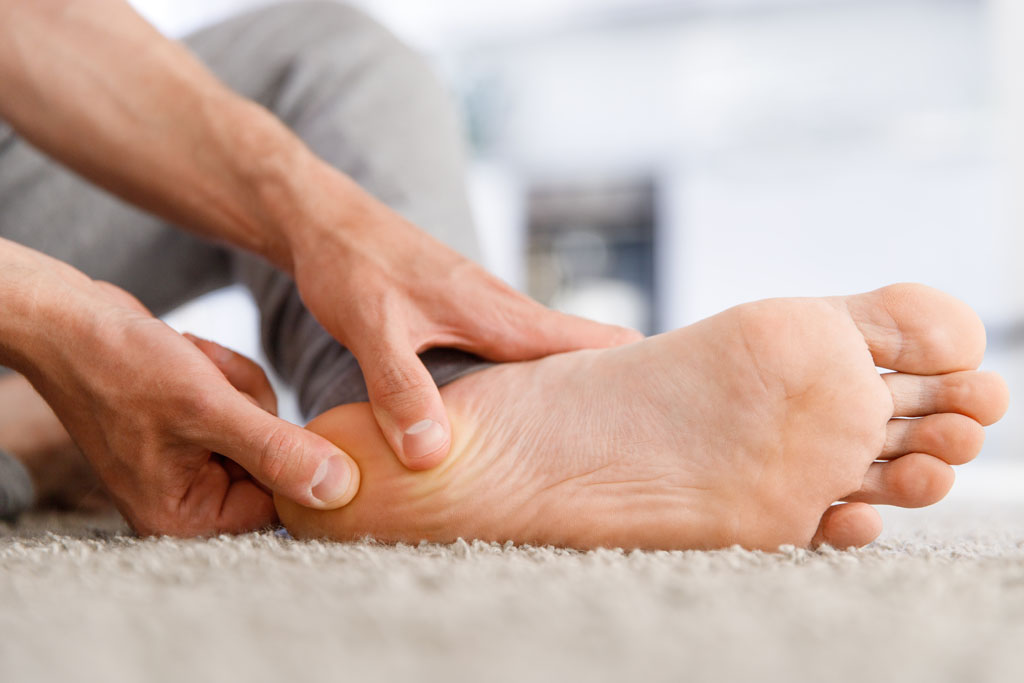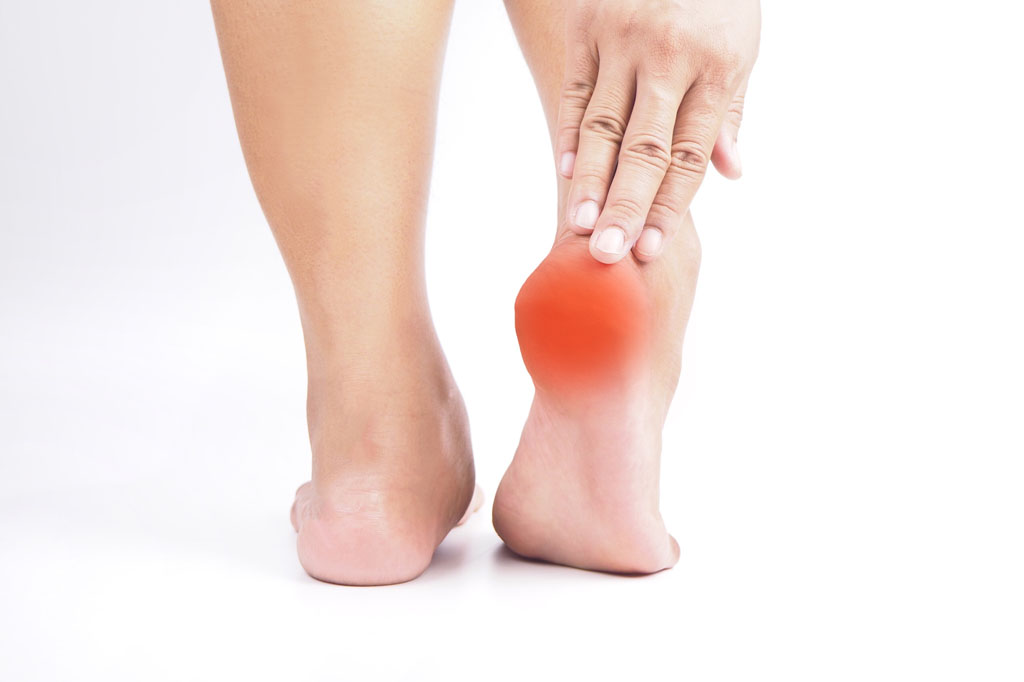Plantar Fasciitis (also known as Heel Spur Syndrome), is a common foot injury felt by people of all ages caused by straining.
What is Plantar Fasciitis?

Plantar Fasciitis is a foot disorder most commonly associated with heel spur pain and nerve pain. It is usually felt in the heel and arch, and it involves the inflammation of the tissues surrounding the area.
The pain is debilitating and can be very uncomfortable. The longer the condition is left untreated, the harder it is to heal. It is, therefore, important to seek advice and treatment as early as possible.
What is Plantar Fascia?
The plantar fascia is a ligament that runs from the heel bone attaching to the ball of the foot. It supports the arch and functions to keep the joints and bones firmly in position during weight-bearing. The plantar fascia helps us to push off from the ground when walking.
Overstretching or bruising of the plantar fascia may cause inflammation, thickening, and pain. When the plantar fascia becomes painful and inflamed, it is called plantar fasciitis.
In some cases of plantar fasciitis, there is a painful heel spur which is the calcification from within the plantar fascia where it originates to the heel bone. Such help spur will develop due to overstretching or trauma from strenuous activities. However, the spur itself does not usually cause the pain associated with heel spur syndrome.
The nerves found under and on the inside of the heel can become entrapped and inflamed if the heel spur is not looked after. When this happens, a sharp pang of pain will occur often described as sensations of “pins and needles.”
What are Common Causes of Plantar Fasciitis?
Every person can get plantar fasciitis, and some certain factors and activities increase the risk of getting it. The following are some of the most common causes in developing plantar fasciitis.
Foot Shape
Foot shape has a massive factor in determining the risk of plantar fasciitis. People with higher arched feet have tighter arch tissues which reduce shock absorption and increases strain to the tissue structures.
On the other hand, people with flat feet tend to have too much strain on the arch of the foot. This can place pressure on the plantar fascia, causing it to elongate beyond its functional capacity and become painful.
Heavy Load and Heavy Weight
The plantar fascia is a ligament that has a major role in carrying your body weight. Anything that places a large load on the plantar fascia may cause injury such as increased body weight or carrying a heavy object. The more burden placed on the soft tissue structure, the more pain and inflammation may occur.
Incorrect Footwear Choices
Wearing wrong shoe sizes can cause the development of plantar fasciitis. Poor arch support or stiff, inflexible soles may damage the plantar fascia. That is why it is important to invest in high-quality shoes, especially if you are active.
Hard Surfaces
Long hours of standing and walking on hard surfaces may cause pain in the plantar fascia.
Sports Engagement
Sports or activities that place a lot of stress on the heel bone or surrounding tissue may lead to plantar fascia strain. Activities that involve a lot of directional changes done on hard surfaces such as running, dancing, and aerobics can cause heel spur syndrome.
Age
While plantar fasciitis may affect people of all ages, middle-aged or older people are more at risk of developing heel pain. As we age, the muscles and tissues supporting the arch grow weaker. Therefore, regular activities can become stressful to the feet and may cause heel spur syndrome.
Pregnancy
Being pregnant causes so many changes in the body. Hormonal changes, gaining extra weight, and feet swelling, are normal parts and effects of being pregnant. These changes, however, can also lead to plantar fasciitis as it increases the pressure on the ligament.
How do I Prevent the Development of Plantar Fasciitis?
 The heel spur syndrome is often a product of people overlooking foot care. There are specific actions that you can do to prevent you from experiencing the discomfort of plantar fasciitis.
The heel spur syndrome is often a product of people overlooking foot care. There are specific actions that you can do to prevent you from experiencing the discomfort of plantar fasciitis.
Choose supportive footwear
Ill-Fitting footwear is the most common cause of plantar fasciitis. Always try to avoid shoes with a high arch or stiff soles. Instead, try to buy footwear with a lace, buckle, or velcro strap, to minimize heel and ankle instability
It is also essential to replace worn-out footwear. A shoes’ support and cushioning wear out over time so it might cause more tension to your feet rather than give the necessary support. Lastly, try not to walk barefoot, especially on hard surfaces.
Stay Healthy
To minimize the stress on the feet, maintaining a healthy weight is necessary. This is so that the plantar fascia would not have to deal with extra pressure in bearing your weight.
If you are physically active, try to avoid activities that mainly exerts stress on your feet. A proper, slow warm up and rest and recovery in between activities is necessary if you are active.
Seek Professional Advice
Genetics play a huge factor in your foot structure. If you think it is the leading cause of your development of plantar fasciitis, you can visit a podiatrist for assessment and advice.
How Can Plantar Fasciitis be Treated?
Treating heel spurs will depend upon the factors on how you developed such condition such as the activities you engage in and your footwear. Mainly, all treatment of plantar fasciitis is aimed at any or all of the following:
Reducing pain and inflammation
This can be achieved by:
- Avoiding activities that cause pain. Try swimming or cycling to maintain your fitness.
- The use of prescription orthotic devices. Orthotic can correct imbalance if the plantar fasciitis is the result of abnormal foot structure.
- Compression. Application of a pressure bandage or sock will help to reduce inflammation.
- Supportive footwear. It is essential to keep your foot well supported to reduce pain and inflammation. A good shoes always go a long way in helping treat plantar fasciitis and you can even opt to wear it around the house.
- Ice. Apply ice in the area for 10 minutes, several times a day. A secure method is to use a frozen water bottle and roll it under the arch of the foot. This also gives the plantar fascia a massage.
- Strapping. Your podiatrist may show you how to strap your foot for additional pain relief.
- Anti-inflammatory medications. The use of non-steroidal anti-inflammatories, such as Ibuprofen and gels such as Voltaren gels is very useful in the short term to reduce pain and inflammation. Your podiatrist will prescribe these medications where indicated.
- Cortisone injections. Cortisone shots is a quick treatment to reduce inflammation. This is a common choice for pain that is too much to bear.
Improving flexibility
The Achilles tendon attaches in the same area as the plantar fascia at the heel. In many cases, the Achilles tendon will be tight and require daily stretching to treat the plantar fasciitis. Your podiatrist may give you exercises to strengthen and stretch your plantar fascia.
Addressing abnormal foot structure
Abnormal foot structure leads to biomechanical dysfunction. The use of prescription orthoses will address this cause of plantar fasciitis. They support the plantar fascia by changing and reducing the angle of force and unloading the painful area.
Surgical Correction
In a few cases, surgical correction is needed as where conservative treatments does not suffice to resolve the pain. Rarely, a nerve entrapment may occur, requiring surgical intervention.
How Long Does It Take to Heal Plantar Fasciitis?
The healing period can vary depending on how long the condition has occurred. That is why it is always best to seek treatment in the early stages. Proper treatment can help cure heel spur syndrome for only 1 to 2 months.






